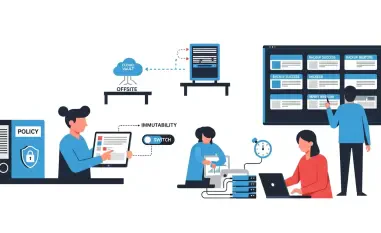In an era marked by rapid technological advancement and an increasingly complex digital landscape, reliance on traditional cybersecurity practices such as scanning and patching faces scrutiny. Despite their longstanding role in the field, these methods are under increasing pressure to adapt amidst a shifting reality characterized by a growing number of sophisticated cyber threats. Organizations worldwide pour significant resources into vulnerability management, yet still grapple with the menace of relentless breaches. This struggle, coupled with the expanding pool of vulnerabilities, begs the question: Are scanning and patching still viable approaches within today’s cybersecurity paradigm, or have they become obsolete tools, unable to match the evolving threats?
Evolving Cybersecurity Threat Landscape
The exponential growth in cyber vulnerabilities poses a formidable challenge for cybersecurity teams, illustrating the necessity for alternative strategies. Recent analysis of data breaches reveals vulnerabilities play a crucial role in a vast number of incidents, aligning in impact with credential abuse and even surpassing phishing as an initial breach vector. Reliance on vulnerability management has matured over time, yet organizations continue to struggle with its effectiveness. The surge in new vulnerabilities is unprecedented, with tens of thousands identified annually. Projections suggest that these figures are not poised to slow down. This sheer volume makes it increasingly difficult for organizations to sift through and prioritize remediations effectively.
Compounding these challenges is the speed at which threat actors exploit vulnerabilities, often within mere minutes of a disclosure. The role of artificial intelligence has revolutionized exploit development, enabling attackers to deploy sophisticated attacks almost instantaneously after a vulnerability becomes public knowledge. This acceleration emphasizes the urgency of implementing robust, dynamic cybersecurity measures rather than solely relying on traditional practices, including scanning and patching. Hence, cybersecurity professionals are challenged to rethink their strategies to preemptively address these nuanced and rapidly advancing threats.
Limitations of Traditional Methods
While vulnerability scoring systems are designed to assess the potential impact of security flaws, they often present inconsistent results, leading to challenges in prioritization. These systems, no matter how refined, can only provide probabilities that can misguide remediation efforts. A poignant example is a CVE that was initially rated “moderate” but became a prominent target for exploitation soon after its disclosure. This inconsistency points to a disconnect between existing vulnerability scores and the real-world threat landscape, which adversaries selectively circumvent using advanced techniques such as fuzzers and AI-driven discovery, exploiting vulnerabilities faster than organizations can react.
Patching, though critical to mitigating risks, has also demonstrated limitations in the context of evolving cyber threats. Research indicates a significant portion of zero-day exploits are merely adaptations of vulnerabilities that had previously been identified and addressed. Attackers frequently revisit these known issues, uncovering new attack paths as digital environments evolve. This recurring pattern indicates that threats evolve faster than the defenses put in place and that relying solely on patch management is no longer an effective deterrent. Cybersecurity must shift toward embracing a more comprehensive approach that factors in the adaptability and persistence of contemporary cyber threats.
The Need for New Cybersecurity Strategies
Given the inherent challenges posed by the growing number and sophistication of vulnerabilities, cybersecurity requires a paradigm shift towards more proactive strategies. Secure-by-Design principles emphasize the foundational incorporation of security measures during the architectural phase of system development. Such an approach ensures that security is not an afterthought or a reactive measure but is instead embedded within the DNA of systems, enhancing resilience against emerging threats. This proactive framework aims to minimize potential risks by addressing vulnerabilities during the design stage, reducing the opportunities for exploitation.
In addition to design considerations, developing and implementing robust runtime security measures is essential in adapting to current challenges. These measures offer dynamic, real-time protection capabilities that monitor and respond to threats as they occur. This ongoing evaluation and adaptation to active threats provide cybersecurity teams with a toolset capable of mitigating risks that evade traditional static practices. By integrating these advanced methodologies, organizations can strengthen their cybersecurity posture and better defend against an ever-evolving threat landscape.
Future Directions in Cybersecurity
In today’s rapidly evolving world, characterized by swift technological progress and a complex digital environment, reliance on traditional cybersecurity methods like scanning and patching is increasingly being questioned. While these practices have long served as fundamental components in cybersecurity efforts, they are now under pressure to evolve due to a landscape marked by sophisticated and varied cyber threats. Organizations across the globe invest considerable resources in vulnerability management yet continue to face relentless breaches, highlighting the persistent struggle against cybersecurity challenges. As vulnerabilities proliferate, it prompts a critical examination of whether scanning and patching remain effective strategies in the contemporary cybersecurity realm. With the complexity and frequency of cyber threats escalating, it raises the question: Can these approaches still stand as reliable defenses, or have they become outdated, unable to keep pace with the rapidly evolving threats and demands of cybersecurity today?













